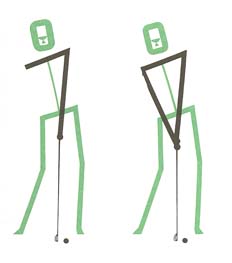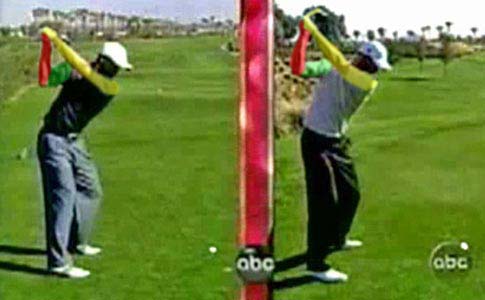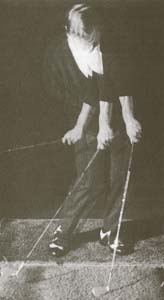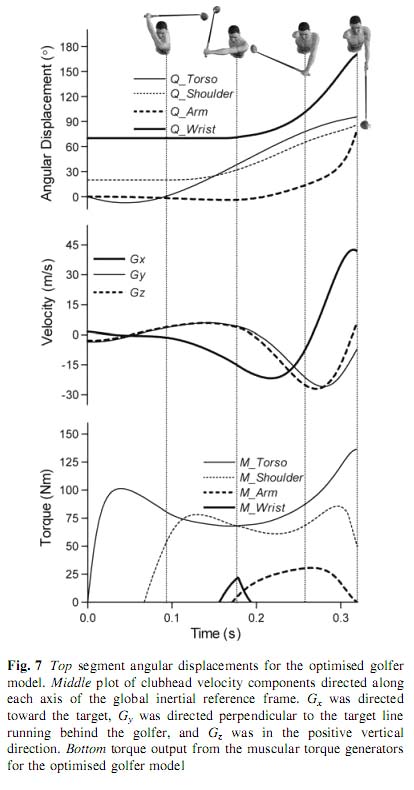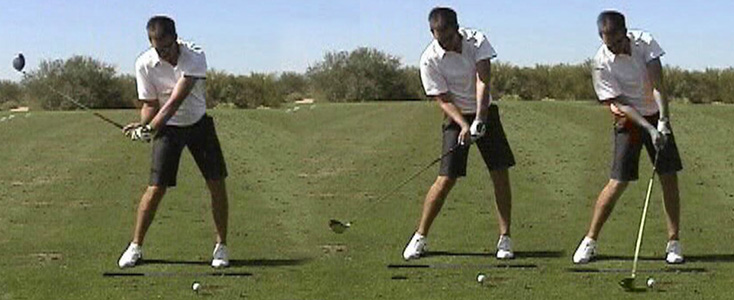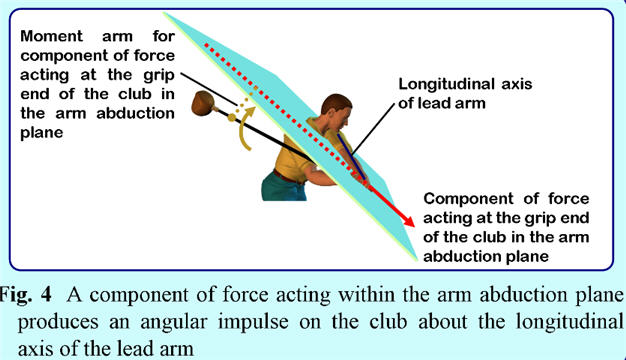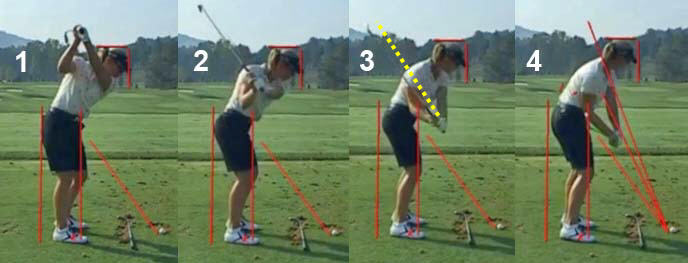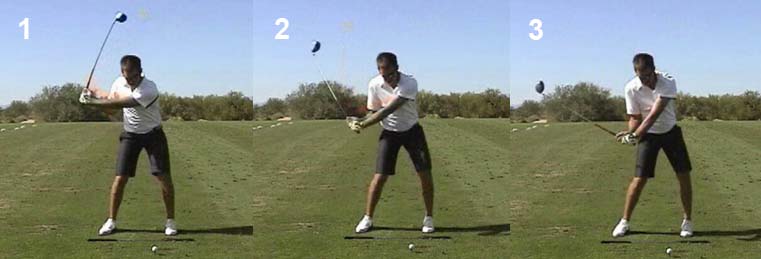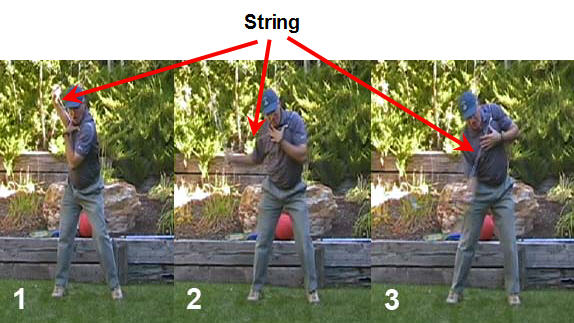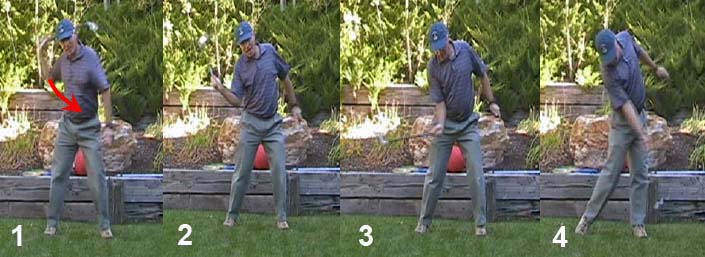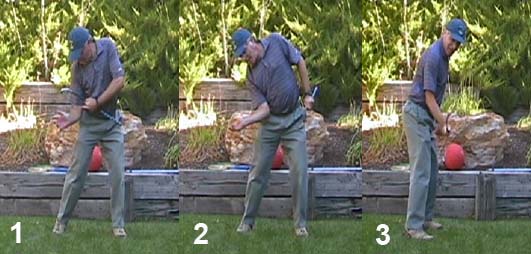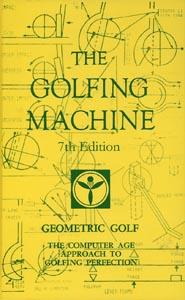Power mechanics of swinging, hitting, and swing-hitting
Click here to go to the home page.
Introduction:
In this review paper, I am going to describe the power mechanics of swinging, hitting and swing-hitting. I first wrote about the topic of power mechanics two years ago in my review paper called "How to Power the Golf Swing", which described the power mechanics of TGM swinging and TGM hitting. I based my description of TGM swinging and TGM hitting on insights that I gained from Homer Kelley's book called "The Golfing Machine" [1]. In that review paper, I didactically stated that a golfer should think of becoming either a swinger or a hitter, and I strongly recommended that a golfer should not mix swinging elements with hitting elements in the same swing. I used the term "switter" to describe a golfer who uses swinging elements and hitting elements in the same swing. During the past two years, my thinking has become more refined and I have moved beyond the limitations of TGM thinking, which believes that the swing styles of swinging (drag-loading) and hitting (drive-loading) are mutually exclusive swing styles. I now believe that it is perfectly acceptable to mix swinging elements with hitting elements in the same swing if a golfer can successfully manage to synergistically mix the two elements in a time-coordinated and synergistically synchronous manner. In this review paper I will describe the evolution of my thinking regarding the topic of power mechanics in a full golf swing, and I will supply a great deal of supportive detail that describes why I have changed my conceptual approach to the topic of swinging versus hitting. I am going to start off by describing the fundamentals of a "pure" swinging technique, and then I will describe how a golfer can modify his technique to become a swing-hitter. Finally, I will also describe my latest thinking on "pure" hitting, and explain why I believe that a four-barrel TGM hitting technique is not a "pure" hitting technique.In this review paper, I am going to presume that a reader understands the relevant TGM concepts regarding the four power accumulators and the concept of the flying wedges. Readers, who are unfamiliar with these TGM concepts, should first read my Backswing Chapter and my How to Power the Golf Swing review paper. I am not going to describe the basic biomechanics of performing a swinging or hitting technique in great detail in this review paper because I have already covered the basic biomechanics in two review papers - in my How To Power the Golf Swing review paper and in my Left Arm Swinging, Right Arm Swinging and Hitting review paper. This review paper is more conceptual in design, and it primarily delineates which power accumulators should be used for different swing style techniques, and it also delineates whether the power accumulator use should conceived to be active or passive.
The mechanics/biomechanics of "pure" swinging
Homer Kelley described the power mechanics of TGM swinging in his TGM book [1], and he stated that it is a pure drag-loading technique. A TGM swinger uses three power accumulators (PAs) in a sequential manner to power the swing - PA#4 which releases the left arm, PA#2 which releases the club, and then PA#3 which represents the roll of the left arm/forearm, and therefore the clubshaft/clubface, into impact.Homer Kelley stated that a TGM swinger usually releases PA#4 via a pivot action, and he stated that the pivot action catapults the left arm forward towards impact. Homer Kelley did not describe the mechanics of the PA#4 release action in great detail, and he did not unequovocally state in his TGM book that there was/was not any involvement of the left shoulder girdle muscles involved in the release of PA#4. I believe that it is very likely that the left shoulder girdle muscles are involved, because the left arm moves along an axis that is more vertical than the axis of rotation of the upper torso. In other words, I believe that there is always a certain amount of independent left arm motion in the left shoulder socket during a swinger's downswing (due to the muscular contraction of the left shoulder girdle muscles), and I believe that this left arm motion must be time-coordinated with the pivot action, so that the left hand reaches impact at the same time as the lower/upper torso achieve their optimum impact alignments (pelvis about 40 degrees open to the ball-target line, and shoulders slightly open to the ball-target line).
Homer Kelley stated that the release of PA#2 (club release phenomenon) is due to a centrifugal release action (passive release action) and that muscular activity (contraction of the left forearm muscles that can ulnar deviate the left wrist and/or contraction of the right triceps muscle that can straighten the bent right arm and thereby apply a push-pressure at PP#3 in the mid-late downswing) is not involved in the release of the club. A CF-release action works according to the principles of the double pendulum swing model [2]. In other words, a golfer simply drags the club by pulling on the grip end of the club with his left hand, thereby exerting a pull-force along the longitudinal axis of the club, and a golfer doesn't use muscles to actively release the club in the mid-late downswing. Club release happens naturally via a natural CF-release action - which operates in accordance with the physics underlying the natural CF-induced club release action.
Regarding the release of PA#3, Homer Kelley did not specifically state that it was powered by the left arm or right arm. In a left arm-only swinger, who does not use the right arm, the release of PA#3 occurs naturally/automatically without power input from the right arm. However, in a two-armed swinger, the right arm can synergistically help to release PA#3 via the biomechanical mechanism of an active right arm straightening action in the late downswing, which applies push-pressure at PP#1 to help roll the left hand into impact.
Let's start-off by considering the swing action of a *left arm-only swinger.
(* I should really refer to this swing pattern as a lead arm-only swing action if I didn't want to manifest a bias in favor of right-handed golfers, but I have always referred to TGM swinging as left arm swinging rather than lead arm swinging in my previous review papers, so I will continue to use that same descriptive pattern).
I previously used this swing video of a left arm-only swinger in my previous review papers - http://www.youtube.com/watch?v=uUTk7m5PozQ
I have recently found another excellent example of left arm-only swinging (actually lead arm-only swinging because the golfer, Sasho MacKenzie, is a lefty).
Sasho MacKenzie's lead arm-only swing.
DTL view - http://www.youtube.com/watch?v=7JW6A_J4KEA&NR=1
Face-on view - http://www.youtube.com/watch?v=GgF_9IfROAU
Sasho MacKenzie (SMK) has a PhD degree in sport's biomechanics, and he has written a number of important research papers on the golf swing [3]. I will be referring to his research papers later in this review.
Note that SMK can drive the ball 250 yards using his lead arm-alone. How does he accomplish that astonishing feat? I think that he is basically using a TGM swinging action - in the sense that he is using a triple barrel swinging action (using PAs 4:2:3 in sequence). Let's consider his swing action in greater detail - I will be reversing his swing action photos in the next series of capture images in order to present him as a righty using a left arm-only swing action.
SMK's backswing action
Sasho MacKenzie's backswing action - capture images from his DTL-view swing video
Image 1 shows SMK at address. He has a neutral left arm and a neutral left hand grip. In the early takeaway (image 2) he acquires an intact left arm flying wedge (LAFW) - clubshaft is straight-in-line with his left arm and the left hand becomes geometrically flat. He then fluidly/efficiently rolls the intact LAFW with its geometrically flat left wrist (GFLW) onto the surface of the inclined plane during his mid-backswing and his clubshaft is "on-plane" in his mid-backswing (image 3). He continues to maintain an intact LAFW throughout the remainder of his backswing until he gets to the end-backswing position (image 4). He uses a traditional backswing pivot action and his shoulders turn horizontally relative to the ground. At the end-backswing position, he has fully loaded PA#4, PA#2 and PA#3 - PA#4 is fully loaded when his left arm is pulled across his upper chest/shoulder turn angle; PA#2 is fully loaded when he his left arm-clusbhaft angle is ~90 degrees; and PA#3 is fully loaded when he has fully pronated his left forearm and significantly internally rotated his left humerus. He also has an intact LAFW and a GFLW at his end-backswing position.SMK's downswing action
Sasho MacKenzie's downswing action - capture images from his DTL-view swing video
SMK starts his downswing with an active pivot action that, combined with left shoulder girdle muscles forces, releases PA#4. Note that he maintains an intact LAFW in his mid-downswing - image 2 - when he is pulling the grip end of the club down the surface of the inclined plane. As he reaches the delivery position - image 3 - he will start rotating his left arm/forearm in the direction of the target. That will change the direction of the left hand's motion in space from being mainly downwards-and-outwards to being significantly forwards. The club has inherent inertia and it will want to continue to travel in the direction it was previously traveling - down-and-out in a direction that is parallel to the inclined plane. The forward movement of the left hand - while the club is still moving down-and-out - will cause the left wrist to automatically/naturally become arched (image 3). In other words, one doesn't have to use a negative torque force at the level of the left wrist in order to acquire a FLW in the later downswing and at impact (image 4) - it will occur automatically/naturally if the left hand actively leads the club into impact. Note that he can successfully rotate his left arm/forearm into impact and square the clubface - without needing a rear-arm to activate/power the release of PA#3 (image 4).
Sasho MacKenzie's downswing action - capture image from his face on-view swing video
Image 1 shows SMK at his end-backswing position. Note that he is sufficiently flexible to get his left arm to the 11+ o'clock position and his clubshaft parallel to the ball-target line.He starts his downswing with an active pivot action - note that his pelvis is square to the ball-target line in image 2, and note that his shoulders have started to rotate. By the time his hands reach waist level - near the end of the mid-downswing (image 3) - he has significantly released PA#4 (with the PA#4-releasing power derived from the pivot action + muscular contraction of the left shoulder girdle muscles). Note that he has still maintained an intact PA#2 (~90 degree left arm-clubshaft angle). It is at this time-point that he starts to release PA#2 via a natural CF-induced release action. Image 4 shows that he has significantly released PA#2 by the time he reaches the first half of his late downswing. At this stage, the back of his left hand is still facing the ball-target line, which means that he hasn't significantly released PA#3. Most of the release swivel action (due to external rotation of the left humerus and supination of the left forearm) occurs in the second half of the late downswing - between image 4 and image 5.
In summary, SMK's lead arm-only swing is very efficient. He always keeps the LAFW intact throughout his backswing and downswing action, and he keeps his clubshaft "on-plane". His pivot action is very quiet and there is no unnecessary swaying or bobbing movements of his torso. He has no difficulty maintaining a ~90 degree clubshaft lag angle until the late phase of the mid-downswing, and his natural CF-induced release of PA#2 is smooth and sufficiently fast. He releases PA#3 efficiently and squares the clubface by impact.
According to SMK, he can generate a clubhead speed of ~95mph with his lead arm-only swing, and a clubhead speed of 110mph using a two-armed swing. So, the important question becomes - how does adding the rear arm increase his clubhead speed by 15mph (~16% increase in speed) if he remains a TGM swinger who uses a triple barrel swing action (sequential release of PAs #4, #2 and #3)?
How can adding the right arm increase swing efficiency and increase clubhead speed in a left arm swinger (TGM swinger)?
I am going to list a number of ways that adding the right arm can help a left arm swinger swing more efficiently and therefore potentially faster.
1) Increasing the efficiency of the takeaway
In their book [4], the authors, Alastair Cochran and John Stobbs, listed three ways that that the right arm can help a left arm swinger. The first way was improving the takeaway action.
They used the following diagram in their book.
One-armed versus two-armed takeaway - from reference number [4]
Cochran and Stobbs suggested in their book that a golfer could perform a smoother takeaway with less clubhead lag using two arms, rather than the left arm-alone. I believe that this is correct - and I demonstrated that point in my grip chapter.
Martin Hall demonstrating a two-armed takeaway action [5]
Note that Martin Hall has placed a door hinge on the back (dorsum) of his right wrist - and that hinge is designed to emphasize the fact that the right wrist should only hinge back (dorsiflex) during the backswing. He has also placed a door hinge on the radial side of his left wrist - and that hinge is designed to emphasize the fact that the left wrist should only cock upwards (radially deviate) in the backswing (and never bend backwards).
Image 1 shows Martin Hall at address. Note that the left wrist is significantly cupped (green angled line). The cupping is greater than the amount of cupping that exists for a GFLW - because the left wrist is slightly bent due to the fact that the clubshaft and left arm are not in a straight line relationship. Note that the right wrist is nearly flat (yellow angle line).
Note what happens at the start of the takeaway - image 2. The right wrist bends backwards (dorsiflexes) and this causes the left arm and clubshaft to become aligned in a straight line relationship - and that constitutes an intact LAFW. The bend in the left wrist disappears and a GFLW is established. From this point onwards, a golfer should start to roll the intact LAFW (and its GFLW) onto the inclined plane. Image 3 shows Martin Hall at the end-takeaway position. Note that his left forearm and GFLW has rotated 90 degrees from its address position. Note that his right wrist has bent back (yellow angle line) more than it was at address.
In other words, dorsiflexion of the right wrist during the takeaway helps a golfer to acquire an intact LAFW with a GFLW, and it also helps to assist the rolling of the intact LAFW onto the surface of the inclined plane by the early mid-backswing.
2) Helping to upcock the left wrist during the mid-backswing and helping to keep the clubshaft "on-plane"
SMK used his left forearm muscles, in conjunction with the momentum of the traveling club, to upcock his left wrist to a 90 degree left arm-clubshaft during his mid-backswing - in his lead arm-only swing. He also ensured that he kept the clubshaft "on-plane" during his mid-backswing. I think that this entire process is made much easier if a golfer uses a right foream takeaway action where the bending right elbow allows the left wrist to cock upwards while the right wrist bends backwards.
Martin Hall demonstrating a two-armed backswing action - from reference number [5]
Image 1 shows Martin Hall at his end-takeaway position.Image 2 shows Martin Hall at his mid-backswing position. Note that he has continued to rotate his left forearm clockwise and that action allows the intact LAFW (with its GFLW) to rotate onto the surface of the inclined plane.
Images 3 and image 4 show Martin Hall nearing the top-of-his-backswing (where his hands are opposite his right shoulder socket). Note that his intact LAFW (colored in red in image 4) is lying against the surface of the inclined plane. His left wrist is still geometrically flat (yellow angled line in image 4). Note that the right forearm flying wedge (RFFW consists of the right forearm and bent right wrist - colored in green in image 4) is roughly at 90 degrees to the LAFW. Note that he has cocked his left wrist upwards by ~90 degrees so that the clubshaft is roughly at a 90 degree angle to his left arm as his left arm gets nearer to its top-of-his-backswing position. Note that the clubshaft has cocked upwards within the plane of the LAFW. Note that his right wrist only bends backwards, while the left wrist is only cocking upwards - and this phenomenon, where the two wrists move in opposite planes (left wrist is cocking upwards in its vertical plane of motion while the right wrist is bending backwards in its horizontal plane of motion), is biomechanically possible because the right elbow is bending during the backswing action.
In other words, the upcocking of the left wrist (in the plane of the LAFW) during the mid-backswing is made easier if one adds the right arm and performs a RFT takeaway action as demonstrated by Martin Hall.
3) Supporting the weight of the LAFW (left arm + clubshaft) at the end-backswing position
If a golfer performs a two-armed backswing action correctly, then he should be able to get the RFFW to support the weight of the LAFW at the end-backswing position.
Tiger Woods and Adam Scott at their end-backswing position - capture images from a swing video
Note how the RFFM (colored in red) supports the weight of the intact LAFW (colored in yellow) at the end-backswing position.4) Increasing the speed and efficiency of the release of PA#3 - optimising the controlled roll of the clubshaft, and therefore the clubface, into impact
In the late downswing, a golfer has to perform a release swivel action where he rolls the clubshaft/clubface so that the clubface can become square by impact. In his lead arm-only swing, SMK has to use his lead forearm muscles to accomplish that goal. However, adding the right arm can greatly facilitate this process and increase the speed and efficiency of the release of PA#3.This represents a major change in my thinking in recent months. I previously under-estimated the amount of torque force that is needed in order to complete the roll of the left arm/forearm, and therefore the clubshaft/clubface, in the late downswing, so that the clubface can become square by impact. If a golfer doesn't apply enough torque force, then he may not be able to successfully complete the release swivel action (release of PA#3) by impact.
Incomplete release of power accumulator number 3 - from reference number [4]
The above photo from Cochran and Stobbs' book [4] shows what happens when the release swivel action (release of PA#3) is incomplete - the back of the FLW doesn't face the target by impact and the clubface is open at impact, and this predisposes to push-sliced shots.Although SMK successfully completed his release swivel action in his lead arm-only swing, many golfers have difficulty completing the release swivel action when using a TGM swinging technique. A likely reason is that those golfers do not use the right arm "correctly" to synergistically help the left arm/forearm rotate into impact, so that the back of the FLW, and therefore clubface, can face the target at impact.
Consider some highly relevant scientific evidence from SMK's research paper [6].
SMK produced a theoretical 3-D model designed to simulate the body dynamics/kinematics and clubshaft/clubhead movement of a low handicap golfer and he also optimised the model to produce maximum clubhead speed at impact. There have been a number of mathematical models based on the double pendulum swing model, but these models are two-dimensional models that only incorporate a maximum of two power generators - a central torque generator at the shoulder center (upper swing center) that torques the central arm (equivalent to the the left arm), and that action represents the release of PA#4; and a peripheral torque generator at the peripheral hinge joint (equivalent to the left wrist joint) that can apply a positive torque at the left wrist joint to actively speed-up the release of the club, and that represents the active release of PA#2. SMK's 3-D model is more advanced in the sense that he also incorporates a torque generator (M arm generator) to roll the left arm around its longitudinal axis, and this action represents the release of PA#3.
Here is a graph showing the torque forces produced by 4 torque generators - M torso is used to rotate the torso and M shoulder is used to abduct the left arm independently at the level of the left shoulder socket (collectively they represent the torque power needed to release PA#4); M wrist is used to actively uncock the left wrist (and actively release PA#2); and M arm is used to roll the left arm 90 degrees around its longitudinal axis (and release PA#3).
Torque output graphs - from reference number [6]
The relevant graphs that you primarily need to consider are the M torque generator graphs at the bottom of the image. The M arm graph represents the torque power exerted by the arm torque generator (M arm) that releases PA#3. Note that it starts to get activated at 0.17 seconds, and it remains active throughout the mid-late downswing, achieving a maximum torque power of ~25Nm. The importance of this M arm graph (from my perspective) is that it made me more clearly appreciate the fact that it takes a fair amount of torque power to rotate the left arm/clubshaft unit (externally rotate the left humerus and supinate the left forearm - thereby rotating the intact LAFW) in the late downswing, so that one can successfully rotate the clubface to square by impact. There is little left forearm supinatory muscle power available in the left forearm to provide the necessary M arm torque power, and a two-armed golfer can therefore selectively/synergistically use the right arm to provide this needed torque power - via a right arm straightening action in the mid-late downswing.Consider the mid-late downswing action of a skilled professional golfer - Aaron Baddeley.
Release of PA#3 in the late downswing - capture images from a swing video [7]
Image 1 shows Aaron Baddeley approaching the delivery position - note that the back of his GFLW is nearly parallel to the ball-target line. Image 3 shows how he has successfully rolled the back of his GFLW, and therefore clubface, ~90 degrees into impact - thereby enabling him to square the clubface by impact. Note that his right elbow is still significantly bent in image 1, and note that his right elbow progressively straightens throughout the late downswing - thereby allowing the right forearm to paddlewheel into impact. The right forearm's paddlewheeling action allows the straightening right arm to supply the torque power needed to efficiently release PA#3 and square the clubface by impact - via a push-pressure force applied at PP#1. Note how the right palm progressively faces the target in the late downswing - as the right elbow straightens - and the right palm plays a major role in rolling the left hand, and therefore clubface, into impact (via push-pressure applied at PP#1). For this entire right-armed process to work with maximum efficiency, a golfer must get his right elbow into its pitch location alongside the front of the right hip by the time he reaches the delivery position and he must also straighten the right elbow with exactly the "correct" amount of force needed to efficiently complete the release swivel action (release of PA#3) - * without applying excessive push-force at PP#1 in a left-lateral direction that can over-accelerate the left hand into impact. If the left hand over-accelerates in the late downswing, then that over-acceleration action can aggravate an "incomplete release of PA#3" problem, and make a "squaring-the-clubface" problem worse (predisposing to push-sliced shots) - this could happen if a golfer allows the right elbow to bypass the right hip area too fast in the late downswing (note that Aaron Baddeley keeps his right elbow close to the front of his right hip area in the late downswing).(* I have demonstrated these issues in my swing video lesson segment number 6 - http://www.youtube.com/profile?user=ImperfectGolfer#p/a/u/1/VAVVzZ55lW0 )
The amount of torque force needed to release PA#3 during the release swivel action is mechanically dependent on the relationship of the clubshaft to the longitudinal axis of the left arm during the mid-downswing. According to SMK's swingplane research, he claims that less positive/muscular torque force will be needed to complete the release swivel action (release of PA#3) if the clubshaft is slightly underplane relative to the left arm [8]. The following diagram demonstrates that principle.
Angular impulse exerted on the club due to the clubshaft being underplane - from reference number [8]
According to SMK, if a golfer is pulling the grip end of the club down the inclined plane towards the ball-target line during the mid-downswing, then the pull force is directed down the inclined plane, which he calls the arm abduction plane. If the clubshaft is below that plane, then a component of that grip pulling force will produce an angular impulse that will rotate the clubshaft upwards towards the inclined plane (gold arrow in the diagram). That force will cause the left arm/forearm to rotate counterclockwise about its longitudinal axis, and a golfer will therefore have to use less M arm muscular torque forces to successfully perform a release swivel action (release of PA#3) in the later downswing. I routinely recommend that a golfer keep the LAFW intact during the early-mid downswing, which means that a golfer should have a GFLW. For a golfer to get the clubshaft slightly underplane (relative to the left arm/forearm), the left wrist will have to arch (palmar flex) slightly, which means that the LAFW is slightly disrupted. A golfer who uses this particular approach is Annika Sorenstam.Consider these capture images from a swing video analysis of her swing [9].
Annika Sorenstam's downswing - capture images from her swing video [9]
Image 1 shows Annika Sorenstam at her end-backswing position. Note that she has a steep left arm angle (relative to her shoulder turn angle). Also, note that her clubshaft is in-line with her left arm/forearm and that she has an intact LAFW and GFLW.Image 2 shows Annika Sorenstam at the end of her early downswing (when her left arm is parallel to the ground). She still has an intact LAFW and a GFLW.
Image 3 shows Annika Sorenstam in her mid-downswing. Note that her clubshaft is slightly underplane relative to her arm abduction plane (yellow dotted line).
Image 4 shows Annika Sorenstam as she reaches close to the delivery position. Note that her clubshaft is even more underplane at this time point, and note that she has an arched (palmar flexed) left wrist.
As she bypasses the delivery position, Annika Sorenstam is going to have to start to rotate her left arm/forearm counterclockwise in order to complete a release swivel action (release of PA#3). According to SMK's swingplane research theory, she will need to use a lesser amount of muscular torque force to successfully complete a release swivel action - as a result of having her clubshaft slightly underplane at this time point in her downswing. Golfers, who have difficulty completing a release swivel action in the late downswing, could also consider using this "underplane-clubshaft" technique by allowing their left wrist to become slightly arched in the mid-downswing. However, I would advise golfers, who use this technique, not to allow the left wrist to become excessively palmar flexed as this will unnecessarily disrupt the LAFW to an excessively marked degree.
5) Increasing the speed, and efficiency, of the club release phenomenon - release of PA#2.
According to the principle of the double pendulum swing model, a golfer's club will automatically/naturally release if the hand arc path is circular (hand direction path is constantly changing direction in a circular manner). In the early downswing, the hand arc path is more "straightish" and it becomes more circular in the mid-downswing. Consider SMK's lead arm-only downswing action.
Sasho MacKenzie's downswing action - capture image from his face on-view swing video
Note that SMK pulls his lead hand down-and-outwards and slighly backwards (away from the target) in the early downswing - image 2. Then, in the mid-downswing (image 3), his lead hand moves more forwards as it continues to move downwards-and-outwards, and that circular motion in the direction of the target causes the club to start releasing via a CF-induced release action - note the widening angle between his left arm and clubshaft. The efficiency of this automatic/natural club release action may be enhanced if the right arm simultaneously/synergistically applies a push-force at PP#1, which helps to ulnar-deviate the left wrist via a wrist torquing action.Consider Aaron Baddeley's early-mid downswing action.
Aaron Baddeley's mid-downswing action - capture images from his swing video [7]
Image 1 shows Aaron Baddeley at the end of his early downswing. Note that his left arm-clubshaft angle is ~90 degrees. Note that his right elbow is still bent at a ~90 degree angle, and note that he is pulling his right elbow down towards his right hip area by actively adducting his right upper arm towards the right side of his torso.Image 2 shows him continuing to actively adduct his right upper arm towards the right side of his torso, and he has retained a ~90 degree right elbow bend angle and a ~90 degree left arm-clubshaft angle.
Image 3 shows his right upper arm adducted against the right side of his torso. Note that his right elbow has straightened slightly and note that his left arm-clubshaft angle is starting to secondarily widen. In other words, the slight straightening action of his right arm is applying a *small torque force at PP#1, thereby synergistically helping to uncock the left wrist - at the same time as the left wrist is being passively uncocked via the natural mechanism of a CF-induced release action.
(* the amount of positive wrist torque force needed to syngergistically augment the CF-induced release force, that is already in play, is actually very small - see the M Wrist graph in the diagram from SMK's research paper)
The timing of the right elbow straightening action is critically important if a golfer wants to have a random release action (like Aaron Baddeley) - rather than an early (sweep) release action.
Consider an amateur golfer who doesn't straighten his right elbow in a correctly-timed manner and who therefore has an early (sweep) release problem.
Anonymous golfer's early release problem - capture image from a swing video
Image 1 shows the anonymous golfer at his end-backswing position - he has a left arm-clubshaft angle of ~90 degrees.
He retains that lag angle in the early downswing (image 2) but he then loses that lag angle due to a premature/early club release in his mid-downswing (image 3 and 4). That is due to the fact that he is prematurely straightening his right arm - either deliberately or unintentionally. To avoid that problem, he must learn how to retain a ~90 degree right elbow bend angle until later in his mid-downswing, and that means that he needs to learn how to actively adduct his right upper arm, so that he can actively drive his bent right elbow down to its pitch location, during his early-mid downswing action. I described this active right arm adduction action in great detail in my downswing chapter.
Another important point is that during the mid-downswing phase of the swing, a swinger must ensure that his right palm is facing partially skywards, so that that it is parallel to the surface of the inclined plane - that fact will allow the right palm to support the LAFW and keep it intact while the left wrist starts to uncock within the alignment-plane of the LAFW. A golfer must avoiding pushing the right palm outwards (towards the ball-target line) during the mid-downswing because that action will prematurely roll the intact LAFW off-the-inclined plane (in an over-the-plane manner) while the club is being released.
A two-armed swinger must also always start releasing PA#2 before releasing PA#3, and how he moves the right arm/forearm/palm in space during the mid-late downswing has a major effect on how efficiently he will release PA#2, and then PA#3, in a sequential manner. Learning how to move the right upper limb "correctly" in space is a learned skill that a two-armed swinger must skillfully learn if he wants to efficiently use his right arm to help optimize his triple barrel swinging action (release of PA#4 => release of PA#2 => release of PA#3).
Finally, it is especially important for a golfer to realise that the right arm's contribution to the sequential release of PA#2, and then PA#3, should be a much more active process, and not a passive process, when a golfer uses a driver (which has a longer clubhead arc) or when a golfer is trying to maximize clubhead speed at impact. If a two-armed swinger wants to generate greater clubhead speed at impact, then he needs to first speed up the release of PA#4 - by increasing the torque force generated by the M torso and M shoulder torque generators. However, in order to square the clubface by impact, he must also be capable of speeding up the release of PA#2/3 and it will likely require a very active contribution from the right arm to efficiently optimise the sequential release of PA#2 and PA#3 in a triple-barrel swinger's action if the swinger is simultaneously trying to maximise clubhead speed.
The question then becomes - if a swinger is using his right arm to apply a push-force at PP#1 to help increase the efficiency of the release of PA#2 and PA#3, is he still a swinger or is he a swing-hitter? My personal opinion is that he will remain a swinger if the right arm's active muscular contribution is perceived to be a supplementary source of PA#2/3 releasing power, rather than being the primary source of power. If a golfer uses his right arm in a more assertive/dominant manner, then it may be better to regard his downswing action as being representative of swing-hitting, rather than swinging.
Consider an example of swing-hitting in the next section of this review paper.
The mechanics/biomechanics of swing-hitting
Brian Manzella, a New Orleans-based golf instructor, advocates a swing-hitting approach in this swing video lesson that he produced at the Mike Jacobs Explosive Golf School.http://www.youtube.com/watch?v=8J2RDXmBxdA
Brian's fundamental theory is that one needs to change the acceleration profile of the release of PA#4 when using a driver (compared to a short iron) so that one can square the driver's clubface by impact. A driver is a much longer club than a short iron, and its clubhead arc is therefore much greater in circumferential length - it therefore takes more time for the clubhead to reach impact for a given amount of release force. Brian therefore recommends that a golfer slow the pivot down when hitting a driver - which should slow down the speed of release of PA#4 via a pivot-induced action. At the same time, he recommends that a golfer apply a push-force with the right hand when the left arm becomes parallel to the ground and the clubshaft becomes vertical to the ground (defined as the end of the early downswing) - and he calls this push-force action "applying a force across the shaft". Although he uses the term "force across the shaft", it should not be presumed that he is recommending the use of a TGM hitter's drive-loading action (which is due to the active release of PA#1 using a punch elbow motion). He is presumably applying a push-force with the right hand to PP#1 at the start of his push-action - because the clubshaft is vertical to the ground when he starts to first apply his push-force. At that point in time his right elbow is still bent, and he must be applying a push-force to PP#1 via an active right upper arm adduction action. That right arm action will primarily speed up the movement of the left hand in a downwards direction - and that means that he is increasing the speed of release of PA#4 using a right armed push-force. As he continues to constantly apply a "force across the shaft" in the later phase of his mid-downswing, he will start to induce the release of PA#2 and then subsequently PA#3. In other words, he is using his right arm in a dominant manner to assist in the release of PA#4 (which is partially released via a pivot action), and to primarily induce the release of PA#2 and then PA#3.
The advantage of his swing-hitting approach is that he can theoretically better control the balance between the release of PA#4 and the release of PA#2/3 by using his right arm in a very dominant manner. His "applying a force across the shaft" action will theoretically allow his right arm to better control the release of PA#2/3 (relative to the speed of release of PA#4) and thereby ensure that he can more likely square the driver's clubface by impact. I think that this "applying a force across the shaft" approach is a very acceptable approach for golfers who have difficulty squaring a driver's clubface by impact. I regard it as a swing-hitting approach because the right arm plays a dominant role in releasing the power accumulators during the downswing action. The disadvantage of this swing-hitting approach is that one needs to synchronise two forces that release PA#4 - a pivot-induced release of PA#4 and a right arm-induced release of PA#4 - and this creates a timing problem. Another disadvantage to this swing-hitting approach is that his right arm "applying the force acrosss the shaft" approach is an "all-out" technique where one continues to apply a constant right arm push-force throughout the remainder of the mid-late downswing (via an active right arm straightening action) - and it is easily possible for an unskilled golfer to i) over-accelerate the left hand into impact (if excessive force is applied at PP#1 in a left-lateral direction) or ii) flip the club prior to impact (if excessive force is applied via PP#3). Each individual golfer can experiment with this swing-hitting approach to determine whether he can better square the clubface by using the right arm in a dominant manner - compared to a "pure" swinger's approach where the right arm only plays a supportive role, and not a dominant role, in releasing PA#2 and PA#3.
"Pure" swinging and swing-hitting have one biomechanical feature in common - they should both use a pitch elbow motion. If a swing-hitter uses the right arm in a dominant manner, then it is easy for an unskilled golfer to unconsciously (non-deliberately) use a punch elbow motion, rather than a pitch elbow motion, and that downswing action can easily rotate the LAFW over-the-plane in a OTT manner (tumbling manner) during the mid-downswing. That OTT move can predispose to an out-to-in clubhead swing path through the impact zone.
The mechanics/biomechanics of "pure" hitting
Homer Kelley introducd the idea of hitting in his TGM book [1], and he described the differences between a hitting technique and a swinging technique in great detail. I described his TGM hitting approach in two review papers - in my How to Power the Golf Swing review paper and in my Left arm Swinging, Right Arm Swinging and Hitting review paper.The basic TGM hitting approach is a triple-barrel hitting technique because it only involves the use of three power accumulators - PA#1, PA#2 and PA#3. PA#1 is the first PA that is used in a triple-barrel hitter's action, and it is due to the active straightening of the right arm (straightening of the bent right elbow) that is biomechanically produced by a very active right triceps muscle contraction. However, the active release of PA#1 only starts to happens in the mid-late phase of the mid-downswing. In the early downswing and early phase of the mid-downswing, HK did not describe the use of any PA in a triple-barrel hitting action. He only stated that a golfer must start the pivot action before releasing PA#1, so that the right shoulder can move closer to the ball before PA#1 is activated. If the right shoulder, which is the launching pad for the right arm's straightening/thrust action, moves closer to the ball before the right arm actively straightens, then this right shoulder action will ensure that a hitter will not run-out-of-right arm before impact.
HK also described a four barrel hitting technique - involving the release of PA#4 before the release of PA#1. HK didn't describe this PA#4 release action action in great detail and TGMers argue about the "correct" way to release PA#4 in a TGM hitter's four-barrel swing action. Most TGM instructors believe that it involves an active downplane thrust motion of the right shoulder, rather than a passive movement of the right shoulder in a downplane direction secondary to a less forceful pivot action. That active downplane thrust motion of the right shoulder will simultaneously rotate the entire upper torso and cause the left shoulder to move up-and-away from the chin. As the left shoulder socket moves towards the target, it pulls the straight left arm along with it and this motion helps to activate the release of PA#4, although part of the activation of the release of PA#4 (release of the left arm) is due to the fact that the right palm is pushing on PP#1 as the entire bent right upper limb (right arm and right forearm bent at a ~90 degree angle relative to each other, together with the dorsiflexed right wrist/hand) is moved downwards-outwards-forwards by the thrusting right shoulder.
Consider a four-barrel TGM hitter's action.
See this Ted Fort video - http://www.youtube.com/user/lynnblakegolf#p/u/78/Drr_JiGsS7Y
Ted Fort, who is an authorised TGM instructor, is balancing a water bottle on his head to demonstrate how stable/stationary he can keep his head during his downswing action.
Ted Fort's TGM-hitting action - capture images from his swing video
Image 1 shows how Ted Fort has loaded his right elbow by the end of his backswing - note that his hands are opposite his right shoulder, while his right elbow is bent and his right forearm is roughly parallel to his bent-over spine angle.During his early downswing, he uses an active pivot action which causes the right shoulder to actively move downplane and the left shoulder to actively move away from his chin - image 2. Note that he maintains a bent right elbow, which means that any right-sided push-force - due to the active downplane motion of his right shoulder, combined with an active adduction movement of his right upper arm - is passively transmitted through his bent right arm to his right palm, which then pushes on the left hand/grip at PP#1, thereby causing the left hand to move away from his right shoulder (and this biomechanical action represents the start of the release of PA#4). However, he cannot avoid pulling the left hand down towards the ball at the same time due to the fact that his active pivot action is also inducing the left shoulder socket to simultaneously move up-and-away from his chin towards the target, and it's forward motion must simultaneously be pulling the straight left arm/hand in a downplane direction. Note that he starts to actively straighten his right elbow in a straight line thrust action towards the ball in the later phase of his mid-downswing (image 3) and he continues to actively straighten his right arm throughout the remainder of his downswing (images 4 and 5) - and that active straightening action of his right arm represents the active release of PA#1, which then induces the secondary release of PA#2 and PA#3 in a drive-loading manner (using a punch elbow motion).
I have demonstrated how an active pivot action causes the left shoulder to pull the left hand/grip end of the club downwards-and-forwards in the early downswing in this swing video lesson segment.
Segment number 9 - http://www.youtube.com/profile?user=ImperfectGolfer#p/a/u/2/gE9V9sHNMhc
Here are a series of capture images from that video segment.
Author demonstrating a four-barrel TGM hitting technique using a string - capture images from my swing video lesson segment
In my swing video lesson, where I demonstrate a four-barrel hitting technique using an active pivot action, I have replaced my straight left arm with a piece of string that is attached to my left shoulder socket area.In my backswing hitting action, I used extensor action to keep the string taut. Image 1 shows my end-backswing position.
Image 2 and 3 shows how the string remains taut during my active pivot action - which causes my right shoulder to actively move downplane while my left shoulder simultaneously moves up-and-away from my chin. Note that I have maintained a bent right arm - which means that I am not changing the distance between my right hand/grip and the right shoulder socket due to lengthening the radius of my bent right upper limb. Note that the string remains taut because the left shoulder socket is moving up-and-away while the grip end of the club is moving downwards-and-forwards. If you, as a fellow golfer, try this experiment - you will soon appreciate how much of the string's "feel" of tautness and how much of the "feel" of the string pulling the grip end of the club downwards-and-forwards is actually due to the left shoulder's motion, rather than being solely due to the presence of a combination of extensor action that is synergistically integrated with the right shoulder/right upper arm thrust action. You will soon realise that it is difficult to avoid pulling the grip end of the club downwards via a left-sided activation of the release of PA#4 secondary to an active pivot action. In other words, a four-barrel TGM hitter, who uses an active pivot action, is also using the pull from the left shoulder to pull the grip end of the club downwards-and-forwards in the early downswing (prior to the release of PA#1), and he is not purely pushing the grip end of the club downwards-and-forwards solely due to a right-sided push action activated by the right shoulder's active downplane thrust action. However, it is also likely correct to assume that most of the force releasing PA#4 in the early downswing will be derived from the right side - and it will result in the right palm pushing the left hand forward via a push-force that is applied to PP#1.
There is another non-TGM hitting technique, which is more "pure", and that is my personal non-TGM hitting technique.
I have described this non-TGM hitting technique in this swing video lesson segment.
Segment 8 - http://www.youtube.com/profile?user=ImperfectGolfer#p/u/3/qtqGud6xTFM
Here are capture images from my swing video lesson segment
Author demonstrating his non-TGM hitting technique - capture images from his swing video segment
Image 1 shows my position at the end-backswing where the right elbow is loaded - the right hand is opposite the right shoulder, and the right elbow is bent to ~90 degrees.
The red arrow demonstrates the first movement that I make when I start the downswing - I actively adduct the right arm towards the right side of my right torso (in the direction of the red arrow) while maintaining the ~90 degree right elbow bend. Image 2 shows how my torso responds reactively to the active right upper arm adduction thrust action (which I have arbitrarily labelled the release of PA#5) - the right shoulder moves downplane, the left shoulder moves up-and-away, and the pelvis starts to shift-rotate. In this video segment, I am holding the grip end of the club with my right hand. In my "real life" golf swing, I would actually be pushing with my right palm against PP#1 in order to power the release of the left arm, with all the power derived from my very active right upper arm adduction maneuver (release of PA#5). The speed of the right upper arm adduction maneuver is faster than the speed of movement of the left shoulder up-and-away (because the pivot is reacting to the active motion of my right upper arms' adduction maneuver) and therefore there is no left-sided pull-contribution to the release of the left arm from the pivot action. All the power used to release the left arm in the early-mid downswing comes from the active right upper arm adduction maneuver (release of PA#5).
At a certain point in my mid-downswing, I actively start to release PA#1 in the standard hitter's manner, and I continue to release PA#1 all the way into impact using the standard hitter's drive-loading action - image 2 and 3. The active release of PA#1 secondarily releases PA#2 and PA#3 in the standard hitter's manner using a punch elbow motion.
This hitting technique can be labelled a four-barrel hitting technique, using the following sequence of power accumulator release -: active release of PA#5 => active release of PA#1 => passive release of PA#2 and PA#3 (secondary to the active release of PA#1).
This hitting technique is a more "pure" hitting technique because it doesn't rely on any left-sided pulling forces (that would occur if I used an active pivot action that actively releases PA#4). This hitting technique may be more suitable for inflexible golfers who cannot use an active pivot action, and/or for uncoordinated golfers who find it technically easier, and biomechanically easier, to use an active right sided thrust action with the right arm combined with a reactive pivot action - rather than a four-barrel TGM hitting action, which uses an active pivot action.
Whatever hitting technique a golfer chooses to use, he must remember to use a punch elbow motion, and not a pitch elbow motion, in his downswing action.
The following composite photo shows the difference between a punch elbow motion and a pitch elbow motion.
Author demonstrating the difference between a punch and pitch elbow motion - capture image from my swing video lesson
Image 1 demonstrates a punch elbow motion where the right elbow ends up alongside the right hip area when the hands reach the delivery position. Most importantly, note that my right palm faces the ball-target line at this time point. That will cause the clubface to be facing slightly groundwards at the delivery position, and the toe of the club will be tilted slightly towards the ball-target line - image 3.Image 2 demonstrates a pitch elbow motion (that is used by a swinger) where the right elbow is usually more in front of the right hip area when the hands reach the delivery position. Note that that the ventral aspect (front of) the right forearm faces more skywards, and that causes the right palm to also face more skywards, so that it can be parallel to the inclined plane - that allows the RFFW and right palm to optimally support the intact LAFW during the mid-downswing action when the intact LAFW lies on the surface of the inclined plane.
Conclusion
In this review paper I have described how a golfer can use different power accumulators to become either a swinger, a swing-hitter, or a hitter. Each individual golfer can independently decide which swing technique to use - based on his body physique, athletic skills and physical handicaps.It is readily possible for a skilled/flexible golfer, who chooses to use a swinging technique, to independently decide whether he even wants to use the right arm as a supplementary power source to assist in the release PA#2 and/or PA#3, or whether he wants to wants to be a "pure" swinger who only uses the right arm for guidance, rather than as a supplementary power source. Many young flexible golfers can probably perform a perfectly fluid and powerful swinging action without any power assistance from the right arm. In fact, they may discover that any attempt to use the right arm as a power source (with the hope that it may fruitfully increase their speed of release of PA#2 and/or PA#3) may actually disrupt their swing action, and have a major deleterious effect, rather than a beneficial effect.
By contrast, there may be another subset of golfers who also prefer to use a swinging action, and who are readily capable of releasing PA#4 with sufficient power using an active pivot action, but who have significant difficulty squaring the clubface by impact. They may benefit by using the right arm as a supplementary power source to assist in the optimal release of PA#3, which should help them more efficiently square the clubface by impact. Individual golfers, who use a swinging technique, can also experiment by using their right arm in a more dominant manner during their downswing action, because they may serendipitously discover that they can strike the ball better, and more consistently, using a swing-hitting technique, rather than a swinging technique. However, a swing-hitting technique requires a much greater level of coordination and synchrony between the left arm's pulling action and the right arm's pushing action - if a swing-hitter wants to avoid becoming an uncoordinated switter.
Finally, an individual golfer may discover that a hitting technique works best for him, and he can then choose to use either a triple-barrel or four-barrel TGM hitting technique, or a non-TGM hitting technique. A non-TGM hitting technique (using a reactive pivot action) is likely to be less powerful, but it may be particularly suitable for elderly/inflexible golfers who are too inflexible to perform an active pivot action.
Jeff Mann.
January 2011.
References:
1. The Golfing Machine. Homer Kelley.
2. The physics of the double pendulum swing model.http://www.tutelman.com/golf/clubs/golfSwingPhysics2.php?ref=#doublependulum
3. Sasho MacKenzie's website and research papersWebsite - http://people.stfx.ca/smackenz
Research papers - http://people.stfx.ca/smackenz/publications.html
4. Search for the Perfect Swing. Alastair Cochran and John Stobbs.
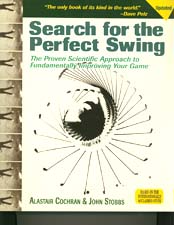
5. Martin Hall Swing video lesson.Available at http://www.youtube.com/watch?v=44fev4wqC6U
6. MacKenzie, S. J. and Sprigings, E. J. (2009). A three-dimensional forward dynamics model of the golf swing. Sports Engineering, 11, 165-175.
7. Aaron Baddeley driver swing video.Avaliable at http://www.v1golfacademy.com/library.asp?ProName=Aaron%20Baddeley
8. Sasho MacKenzie's swingplane research.Available at http://people.stfx.ca/smackenz/swingplane.html
9. Wayne DeFrancesco's swing video analysis of Annika Sorenstam's swing.Available at http://www.youtube.com/watch?v=pwxI5IynxTE



